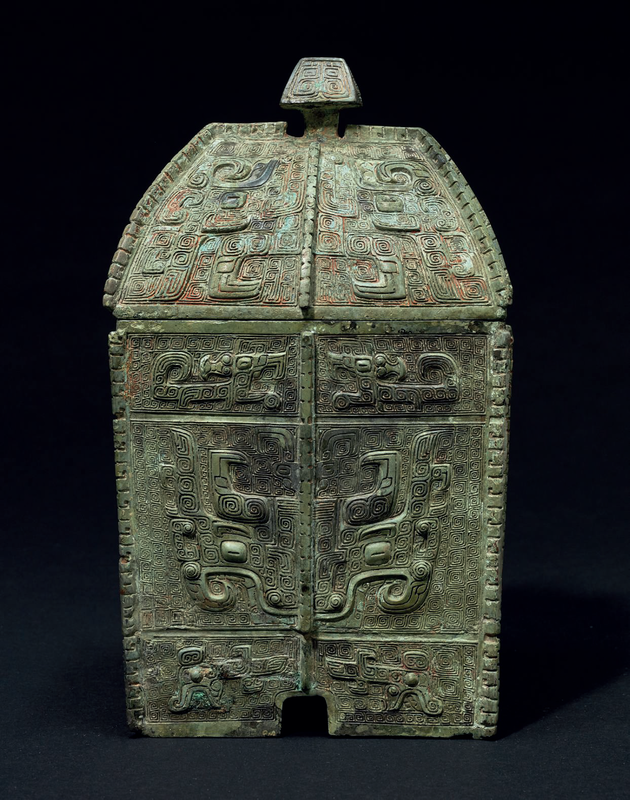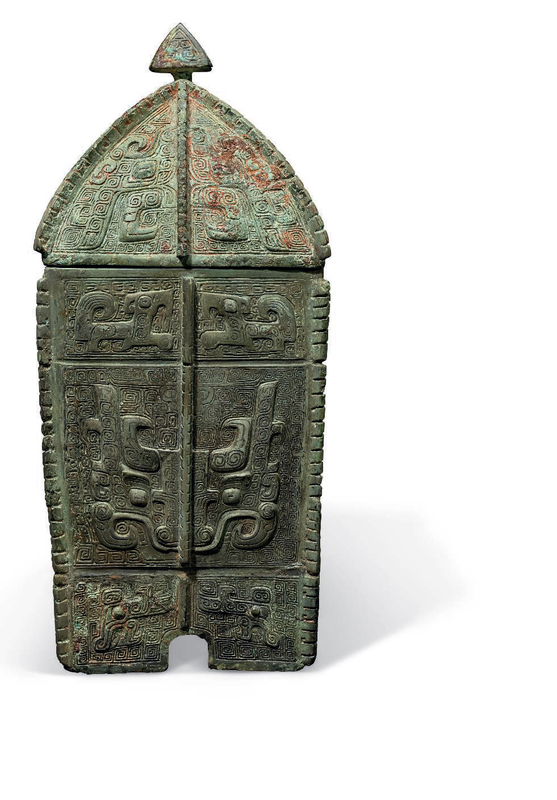A rare and finely cast bronze ritual wine vessel and cover, fangyi, Late Shang dynasty, 13th-11th century BC
Lot 1604. A rare and finely cast bronze ritual wine vessel and cover, fangyi, Late Shang dynasty, 13th-11th century BC; 9 in. (22.8 cm.) high. Estimate USD 1,500,000 - USD 2,500,000. © Christie's Images Ltd 2019
Provenance: Raymond A. Bidwell (1876-1954) Collection, Springfield, Massachusetts.
The Springfield Museums, Springfield, Massachusetts, accessioned in 1962.
Christie's New York, 21-22 March 2013, lot 1126.
Mr. and Mrs. Raymond A. Bidwell on the porch of their home at 16 Ridgewood Terrace, Springfeld, Massachusetts. Photographer unknown
Raymond A. Bidwell (1876-1954) practiced law in Springfeld, Massachusetts, and served as a city prosecutor from 1910-1911 and an assistant city solicitor from 1914-1918. He also was a Trustee of the Springfeld Library and Museums Association from 1943 until his death in 1954.
As an undergraduate at Harvard College (1895-1899), Mr. Bidwell purchased his frst Japanese print and piece of Chinese pottery. These early acquisitions sparked a life-long interest in collecting. Mr. Bidwell selectively purchased a few objects each year toward the goal of forming a collection that traced the historical developments of Chinese bronzes, pottery and porcelain. The high quality of his taste is clearly demonstrated by this superb Shang bronze fangyi.
Literature: The Raymond A. Bidwell Collection of Chinese Bronzes and Ceramics, Museum of Fine Arts, Springfield, Massachusetts, 1965, pp. 24-25.
R. Spelman, The Arts of China, C.W. Post Center, Greenvale, New York, 1976, p. 19, no. 6.
C. Deydier, Understanding Ancient Chinese Bronzes, Their Importance in Chinese Culture, Their Shapes, Functions and Motifs, 2015, pp. 34-35 and 109.
Exhibited: Greenvale, New York, C.W. Post Center, Long Island University, The Arts of China, 4 February - 27 March 1977.
Note: With its successful combination of elegant proportions, strong shape and fine execution of details, this vessel represents the most refined bronze casting tradition of the late Shang period. A similar fangyi, formerly in the collection of Arthur M. Sackler, and now in The Metropolitan Museum of Art, New York, is illustrated by Max Loehr in Ritual Vessels of Bronze Age China, New York, 1968, pp. 90-91, no. 37, in which the author notes “I know of no other Fang I to match this exquisite specimen in proportions, design, and refined technique.” The present fangyi may be considered to be of similar quality as the Metropolitan Museum of Art fangyi.
Fangyi appear to have been one of the most prized of ritual vessels, as they have been found in fewer and more sumptuous tombs than more common shapes such as gu, jue, and ding. The term fangyi is a traditional attribution made by Song dynasty (AD 960-1279) scholars. Fang literally means square and refers to the faceted form. Yi is a general term for ritual vessels. Although current scholarship classifies fangyi as wine vessels, ancient scholars as well as some prominent modern scholars such as Chen Mengjia and Bernhard Kalgren believed that fangyi are food vessels: see C. Deydier, Understanding Ancient Chinese Bronzes, Their Importance in Chinese Culture, Their Shapes, Functions and Motifs, 2015, p. 34.
For a full discussion of the evolution of the fangyi, see C. Deydier, ibid, p. 37. The author notes that fangyi were made of pottery in the Neolithic period and were also made of white marble in the Shang dynasty. Bronze fangyi first appeared at the beginning of the Yinxu period (13th-11th century BC) or perhaps during the transitional phase between the end of the Erligang period and the beginning of the Yinxu period, circa 14th century BC, and disappeared at the beginning of the Western Zhou dynasty.
The decoration on all fangyi is arranged in registers, and typically feature with a large taotie mask on the body, small dragons or birds on the foot and above the mask, and either a large taotie repeated on the cover or, in at least one instance, a bird. See R.L. d’Argencé, The Hans Popper Collection of Oriental Art, Japan, 1973, no. 2, for the latter. In some instances the decoration is flat-cast or the decorative motifs are filled with leiwen scrolls.
A fangyi of very similar form and decoration, but with a band of bird motifs below the mouth rim, from the Ernest Erickson Collection, is illustrated by R. Bagley, Shang Ritual Bronzes from the Arthur M. Sackler Collections, Washington D.C., 1987, p. 435, fig. 77.15. Another similar fangyi in the Hakutsuru Art Museum, Kobe, is illustrated in Zhongguo qingtongqi quanji: Shang 4 (Complete Collection of Chinese Bronzes: Shang 4), vol. 4, Beijing, 1998, no. 73. Another comparable fangyi, formerly in the collections of Gladys Lloyd Robinson and the British Rail Pension Fund, was sold at Christie’s New York, 24 March 2004, lot 106.
Christie's. Fine Chinese Ceramics & Works of Art, New York, 22 March 2019

/https%3A%2F%2Fprofilepics.canalblog.com%2Fprofilepics%2F1%2F0%2F100183.jpg)
/https%3A%2F%2Fstorage.canalblog.com%2F03%2F02%2F119589%2F96711876_o.jpg)
/https%3A%2F%2Fstorage.canalblog.com%2F11%2F31%2F119589%2F94773502_o.jpg)
/https%3A%2F%2Fstorage.canalblog.com%2F20%2F83%2F119589%2F94772815_o.jpg)
/https%3A%2F%2Fstorage.canalblog.com%2F26%2F72%2F119589%2F75604929_o.jpg)
/https%3A%2F%2Fstorage.canalblog.com%2F59%2F60%2F119589%2F26458628_o.jpg)








/image%2F1371349%2F20240406%2Fob_b23648_434058570-1644317966338216-88086167391.jpg)
/image%2F1371349%2F20240403%2Fob_6d5ae7_dp-28103-001.jpg)
/image%2F1371349%2F20240229%2Fob_8f31f9_431013694-1625286614908018-33034430839.jpg)
/http%3A%2F%2Fstorage.canalblog.com%2F79%2F20%2F119589%2F129837997_o.jpg)